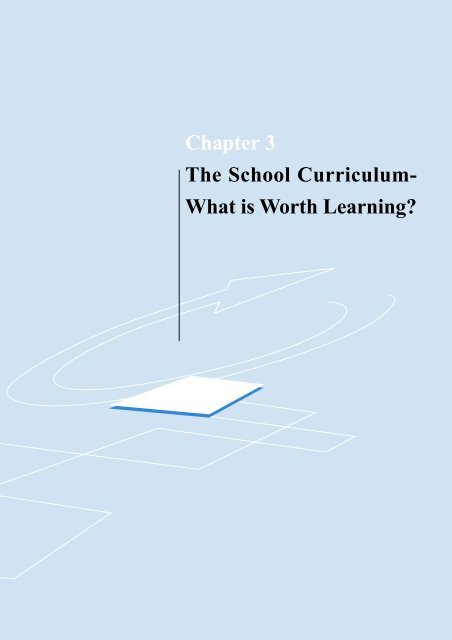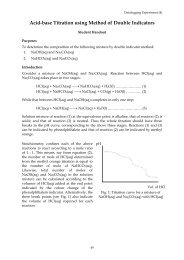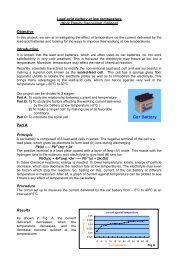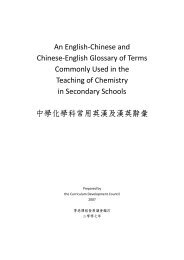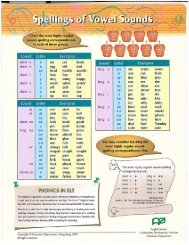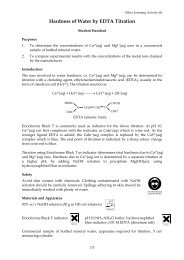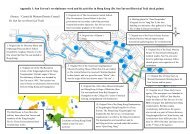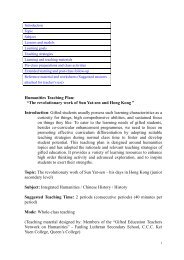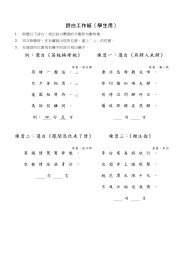Chapter 3_19-29 - Www2.hkedcity.net
Chapter 3_19-29 - Www2.hkedcity.net
Chapter 3_19-29 - Www2.hkedcity.net
Create successful ePaper yourself
Turn your PDF publications into a flip-book with our unique Google optimized e-Paper software.
<strong>Chapter</strong> 3The School Curriculum-What is Worth Learning?
Purpose of the <strong>Chapter</strong>• This chapter answers the question "What is worth learning?" as ameans for our students to achieve whole-person development andlife-long learning. The contents of this chapter will form the basisfor the following work in the short-term phase 2001-02 to 2005-06:➩ Teachers and schools are to improve the existing curriculumwhilst in transition to a new framework. The actions to be takeninclude trimming obsolete or less essential content, restructuringschool subjects, infusing critical thinking, creativity andcommunication into the learning and teaching of existingsubjects, and opening up more space for learning.➩ CDC committees are to develop curriculum guides on differentstages of schooling, KLAs/subjects, and General Studies forPrimary Schools between 2002 _ 2006 (schedule shown in<strong>Chapter</strong> 5).• The curriculum guides scheduled for publication in 2002 _ 2006 willbe based on recommendations in this chapter. They will providedetails on the learning targets of each Key Learning Area (KLA)framework, the organisation of contents, the learning, teaching andassessment strategies, the resources, exemplars and other usefulinformation for the reference of teachers. However, it is not thepurpose of this chapter to present details of the above.Meaning of the Curriculum• The school curriculum defines the views of society about 'what isworth learning’, commensurate with students' abilities at differentstages and with their ways of perceiving and learning about theworld.• We have to move away from the concept of the curriculum as"documents" to the concept of the curriculum as "learningexperiences" to enhance the effectiveness of learning.• Learning experiences are a nexus of➩ aims➩ learning processes➩ learning contents➩ social environment<strong>19</strong>
Five Essential Learning ExperiencesAll students should be entitled to the following five learningexperiences that correspond to “ethics, intellect, physique, social skillsand aesthetics” for whole-person development stated in the aims ofeducation (Education Commission,2000):• Moral and civic education - developing➩ personal character and interpersonal skills➩ respect for others➩ perseverance➩ national identity• Intellectual development➩ laying a firm foundation of knowledge➩ enjoyment in learning• Community service - developing➩ commitment➩ responsibility• Physical and aesthetic development➩ leading to healthy living styles➩ appreciating aesthetic qualities• Career-related experiences➩ linking studies with career aspirations and job opportunitiesPre-primary Curriculum• A pre-primary curriculum geared to providing a high quality,integrated early education and childcare service should have thefollowing key features:➩ Relevant and appropriate content that matches children's needsand interests➩ Provision of learning experiences that build on children's priorknowledge and previously acquired skills➩ Learning through play20
➩ Opportunities for children to engage in activities that are initiatedby themselves➩ Theme-based learning➩ No textbook used at the nursery class level. Lower and upperkindergarten classes may choose to use resource packages aslearning materials➩ Use of children's mother tongue as the medium of instruction➩ Observation records on children's performance and progressmade in various developmental aspects as the core assessmentdata➩ Strong collaboration among practitioners, parents andcommunity service workers• In pursuance of the unification of pre-primary services, a combinedcurriculum guide for kindergartens and child care centres wasissued in September <strong>19</strong>96. This Guide, which is for the use of allpre-primary institutions in both sectors, suggests the design of aquality curriculum to achieve the aim of all-round development,and the cultivation of a positive attitude towards learning, goodliving habits and creativity.Curriculum Framework and Components forPrimary and Secondary Schools• A curriculum framework is developed as the basic structure forsetting the learning targets and ensuring the standards of studentsat various stages of schooling. The framework is composed of threeinterconnected components:➩ Key Learning Areas➩ Generic Skills➩ Values and Attitudes• High expectations in Asian society and explicit goals areimportant factors in effective learning. Learning targets of KLAs,generic skills, values and attitudes are set for student to➩ acquire the basic knowledge/concepts needed for an adult worldin the eight Key Learning Areas➩ develop the generic skills necessary for independent andlife-long learning through the KLAs, General Studies for PrimarySchool and other meaningful contexts21
➩ nurture positive values and attitudes for whole-persondevelopmentProposed Curriculum Framework:The proposed Curriculum framework iscomposed of three interconnectedcomponents: Key Learning Area, GenericSkills, Values and AttitudesKey Learning Areas• A Key Learning Area➩ is a subset of a curriculum structured around fundamental andconnected concepts within major knowledge domains➩ provides the context for the development and applicationof generic skills, values and attitudes➩ serves as a context for the development of understanding at adeep level and for the construction of new knowledge➩ provides the platform for reviewing elements of learning• The existing subjects are grouped into eight Key Learning Areas:➩ Chinese Language Education➩ English Language Education➩ Mathematics Education➩ Personal, Social and Humanities Education (PSHE)➩ Science Education➩ Technology Education➩ Arts Education➩ Physical Education22
• Schools are recommended to choose subjects from each group inorder to provide a broad and balanced curriculum for students atall levels. (Appendix I - Existing Subjects and New Subjectsunder the Key Learning Areas(KLAs) for 2001-02 to 2005-06)• In each Key Learning Area, studies can be in the form of subjects,modules, short courses, projects, etc. Schools can organise theircurriculum in different ways using a combination of these.• General Studies for Primary Schools covers moral and civiceducation and interconnected knowledge/concepts which arerelevant to students' daily life, notably from PSHE, science educationand technology education, as well as elements from other KLAs.The Issue of Chinese History and Culture• The study of Chinese history will be strengthened in the 9-year ofbasic education by the following:➩ National identity and Chinese culture is one of the six strands inthe new framework for General Studies for Primary Schools(Consultation Document on Learning to Learn - The WayForward in Curriculum Development, November 2000).➩ Students in all types of junior secondary schools will studyChinese history and culture, because Chinese history andculture are part of the Essential Contents for Learning in the PSHEKLA.➩ Chinese History will remain as independent subjects in juniorsecondary, secondary 4-5, and secondary 6-7 levels.➩ Traditionally, Chinese history and world history have beenstudied separately. The one _ history approach should useChinese history as the main thread of study. It will be piloted asa mode of study in PSHE among other modes.➩ In 9-year basic education, Chinese will be used as the mediumof instruction for the learning and teaching of Chinese history.• There was a suggestion to form a ninth KLA of "National Historyand Guoqing Jiaoyu ( 國 史 及 國 情 教 育 )". "Guoqing Jiaoyu" ( 國 情教 育 ) is a component of moral and civic education, which is oneof the five essential learning experiences for whole-persondevelopment. Both "Guoqing Jiaoyu" ( 國 情 教 育 ) and moral and civiceducation involve values such as national identity, responsibilityand commitment to improving society and our nation. A sense ofnational identity is cultivated through understanding elements ofChinese history and culture, (e.g. history events, arts, scientific23
and technological development, achievements of outstandingChinese) which permeate all KLAs. Moral and civic educationshould be internalised through school life and life-wide learningactivities within the KLAs or through realising oneself in life events.A life event approach to moral and civic education is advocated inthis report. Therefore it is not desirable to separate "Guoqing Jiaoyu"( 國 情 教 育 ) from moral and civic education to form a ninth KLA withChinese history.Generic Skills• The recommendations on the development of generic skills havebeen widely accepted by public consultation.• Generic skills are not developed in a vacuum, but should bedeveloped through the learning and teaching of the KLAs,General Studies for Primary Schools, or other contexts andactivities, for example in project learning, reading, interactivelearning on the Inter<strong>net</strong>.• Generic skills are fundamental in helping student to➩ learn to acquire knowledge➩ construct knowledge➩ apply knowledge to solve new problemsRefer to ExemplarsI. 1.2 閱 讀 與 思 考 計 畫I. 2.3 Using Imaginative andLiterary Texts to DevelopCreativity, CriticalThinking and CulturalAwareness : "Where gothe boats?"I. 3.2 Formulating AlgebraicEquations in WordProblemsI. 4.3 培 養 批 判 性 思 考 能 力 —觀 點 與 角 度I. 4.4 培 養 批 判 性 思 考 能 力 —教 學 活 動I. 5.1 Developing CriticalThinking and ProblemSolving Skills throughthe Design ofExperimentsI 7.1 自 然 之 音The 9 Generic Skills1. Collaboration skills (e.g. listening, appreciation, and negotiation)help students to engage effectively in tasks and teamwork, andto benefit from collaborative relationships.2. Communication skills help students to interact with people andexpress their ideas effectively.3. Creativity is the ability to generate original ideas and solveproblems appropriate to the contexts.4. Critical thinking skills help students to draw out meaning fromgiven data or statements, generate and evaluate arguments,and make their own judgement.5. Information technology skills help students to seek, absorb,analyse, manage and present information critically andintelligently in an information age and a digitised world.6. Numeracy skills help students to master basic computation indaily life, use basic mathematical concepts in practical situations,make reasonable estimates, understand and interpret graphs,charts, and data.24
7. Problem-solving skills help students to use thinking skills toresolve a difficulty and determine the best course of action.8. Self-management skills (e.g. preserving emotional stability,handling stress) help students to build up self-esteem andaccomplish goals.9. Study skills (e.g. collecting and processing information) helpstudents to develop good learning habits, and the abilities andattitudes to enjoy learning.Learning to Learn - The Way Forward in Curriculum Development(November 2000)• Since public feedback indicated that the curriculum reformenvisaged is too broad, a priority focus will be placed on thedevelopment of three of these generic skills, namely communicationskills, creativity and critical thinking skills, though the others shouldnot be neglected.Values and Attitudes• Values are qualities that students should develop as principlesunderpinning conduct and decision-making, for example, rights andresponsibilities, commitment, honesty and national identity.• Attitudes support motivation and cognitive functioning. They areneeded to perform a task well, for example, open-mindedness,co-operativeness, perseverance and resilience.• Values and attitudes mutually affect each other.• A set of values and attitudes given in Appendix II is recommendedfor incorporation into the learning targets of each KLA frameworkwhenever appropriate.• The development of values and attitudes such as responsibility,commitment, respect for others, perseverance and national identityis considered important for the short-term phase (2001-02 to2005-06). They are necessary for developing goals in life and learning.It is recommended that they will be fostered through moral andcivic education (one of the four key tasks) and also across KLAs inappropriate themes, learning and teaching strategies.• Value-oriented studies such as religious education, sex education,health education, environmental education and media education,or similar studies with different terminology (affective education,life education) can be taken as an integral part of moral and civiceducation. A life-event approach to moral and civic educationcovering value-oriented themes is advocated (<strong>Chapter</strong>s 4 and 5).25
A list of suggested life-events for moral and civic education isoffered in Appendix IIIAdvantages and Concerns of the CurriculumFramework• The Curriculum Framework allows for different treatment of➩ interpretation of contents➩ scope of contents➩ depth• It allows flexible use of different learning strategies and styles tosuit different learners so long as the learning targets are achieved.• It ensures coherence across KLAs/subjects.• It ensures continuity of learning across levels.• It facilitates easy updating through modifying the learning targets.• The concern of an open framework is that teachers may find thingsless concrete and worry about the workload. It takes time forteachers who are used to prescription to exercise more autonomyand liberate student learning. Measures to support schools arepresented in <strong>Chapter</strong> 5.• It is a valid concern that the systematic study of subject disciplineswill be lost. Both integrated learning experiences (integratedstudies) and discipline-based studies (e.g. physics) are valuable forstudents. Therefore, students should be given opportunities tostudy both.Connections across KLAsIn real life, the learning experiences of students transcend theboundaries of knowledge domains. Cross-KLA studies also allowstudents to see things from different perspectives. The followingmeasures will enrich the learning experiences of students:• A new curriculum framework for General Studies for PrimarySchools that is not merely a combination of the old primary science,social studies, and health education• Liberal Studies at Advanced Supplementary level for S6-726
• Two new HKCEE subjects of Integrated Humanities (for science andtechnology-oriented streams) and Science and Technology (for artsstreams) to serve a broadening function in 2003-04 for S4 students• Life-wide learning opportunities outside the classroom in authenticenvironments, e.g. community, museum, home (<strong>Chapter</strong> 4)Refer to ExemplarI. 7.2 非 洲 藝 術 與 文 化• Learning activities involving looking at things from differentperspectives• Learning activities like project learning, inquiry learning(<strong>Chapter</strong> 4).What is "Trimmed" in the Curriculum?• It is a common public perception that the curriculum is"overloading" students and should therefore be trimmed.• The "overloading" of students derives from a mixture of problemssuch as overlapping and outdated content, over-teaching, poorlearning and ineffective teaching. It is not necessarily due to excessivecontents.• The open framework proposed above provides the flexibility forschools to adapt the curricula to different needs of students.However, in the transition towards using the new curriculumframework by 2006, the approach to "trimming" involves thefollowing:Refer to ExemplarI. 9.1 締 造 空 間 、 加 強 學 習➩ Taking away outdated contents and non-essential details,and leaving more space for student learning✧ Teachers of General Studies for Primary Schools cantrim away the unnecessary detail in the existing GeneralStudies curriculum (CDC, <strong>19</strong>97) to create more space forlearning (Appendix IV)➩ Core, Extensions, and Additional Learning Space✧✧The junior science curriculum implemented in 2000 providesa core component, while using spare curriculum time forstudents to plan, design and conduct science investigationsin order to develop process and thinking skills.The revised mathematics curriculum for primary schools tobe implemented in 2002 provides enrichment activities/topics.27


